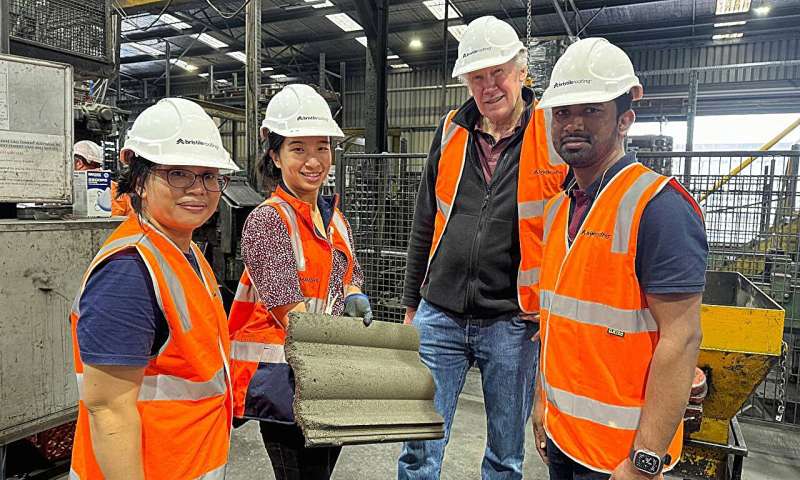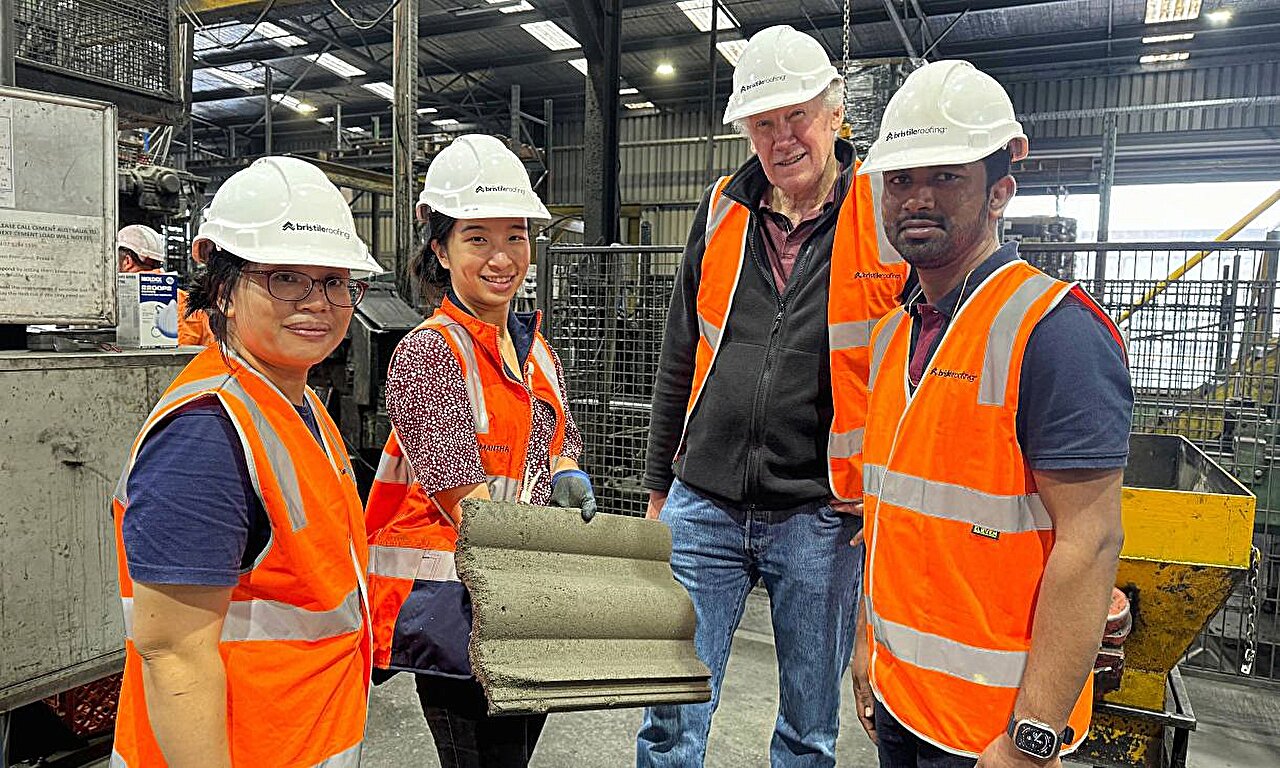
Yulin Patrisia from RMIT, Samantha So from Bristile Roofing, Dr. RMIT's David Law and student Madushan Mudiyanselage at the Bristile factory in Dandenong. Photo credit: RMIT University
A large-scale trial of sustainable roof tiles by RMIT and Bristile Roofing has shown that incorporating coal ash and glass waste can reduce their carbon footprint.
The large-scale production trials at Bristile Roofing's Melbourne factory produced hundreds of concrete tiles containing ash waste from coal-fired power plants and glass – two challenging waste streams – that brought both environmental and technical benefits.
The finished product was lighter and more fire resistant while meeting Australian standards for strength and durability.
A comprehensive circular economy analysis of the new tiles, covering the entire process from raw material production to end-of-life landfill, revealed a 13% reduction in CO₂ emissions compared to traditional concrete tiles.
RMIT project leader Dr. Chamila Gunasekara said this significant environmental benefit was largely due to the use of harvested pond ash and unwashed recycled glass sand, avoiding energy-intensive processing and effectively replacing virgin materials.
“By replacing 10% of cement with harvested pond ash and 10% of river sand with unwashed glass waste – replacing a total of 20% virgin material – we are not only reducing waste going to landfill, but also producing an improved concrete product with increased fire resistance, a valuable feature for roofs in the Australian climate,” he said.
In Australia alone, electricity generation produces around 12 million tonnes of coal ash annually, with more than 400 million tonnes of coal ash stored in large tailings ponds.
Likewise, more than 1.3 million tons of glass waste is generated every year, more than half of which still ends up in landfills.
RMIT Principal Research Fellow, Dr. Yulin Patrisia, said the trial proved that we can integrate significant amounts of these industrial wastes without compromising on quality and safety.
“While harvested pond ash is less reactive – primarily due to prolonged storage in tailings ponds – it remains an attractive material due to its abundance and contribution to long-term engineering performance,” Patrisia said.
“Despite its lower early reactivity, it helps improve concrete performance over time. Our testing showed better dimensional stability, reduced shrinkage cracking and continued strength growth – making it ideal for permanent, non-structural applications.”
The technical performance of the product is described in Sustainable materials and technologieswhile the environmental impact assessment was published in The International Journal of Life Cycle Assessment.
Further collaborations are currently underway with local governments and commercial partners to test the roof tiles under real conditions. “This is more than just a laboratory success,” Gunasekara said. “We are ready to scale this for the industry.”
To achieve this, expansion requires identifying reliable local waste resources that have consistent quality, availability and sufficient quantity.
Expand impact from roof tiles to bricks
Concrete mix design also has broader applications than just roof tiles.
Another of the team's prototypes is concrete blocks made from 15% harvested pond ash and 20% unwashed glass sand – a total of 35% waste materials – while meeting Australian standards for load-bearing structural concrete and fire protection for wall elements.
Analysis showed that the use of these waste materials also improved insulation and reduced heat loss by 30% compared to traditional cement bricks.
The technical performance results were published in Building Materials Case Studies.
The team is moving forward with manufacturing trials for the concrete brick product in collaboration with an industry partner.
Further information:
Yulin Patrisia et al., Advanced production of waste-integrated concrete roof tiles: Scaling up to TRL 6, Sustainable materials and technologies (2025). DOI: 10.1016/j.susmat.2025.e01461
Yulin Patrisia et al., Evaluation of waste-integrated concrete products: a cradle-to-cradle perspective, The International Journal of Life Cycle Assessment (2025). DOI: 10.1007/s11367-025-02443-w
Yulin Patrisia et al., Optimizing the Technical Potential for Sustainable Structural Concrete Bricks Using Pond Ash and Unwashed Recycled Glass Sand Integration, Building Materials Case Studies (2024). DOI: 10.1016/j.cscm.2024.e03816
Provided by RMIT University
Quote: Low-carbon roof tiles give industrial waste a new home (2025, October 27), retrieved October 28, 2025 from https://techxplore.com/news/2025-10-carbon-roof-tiles-industrial-home.html
This document is subject to copyright. Except for fair dealing purposes for private study or research, no part may be reproduced without written permission. The content is for informational purposes only.
